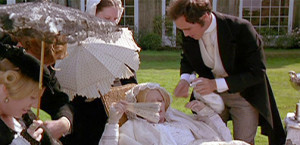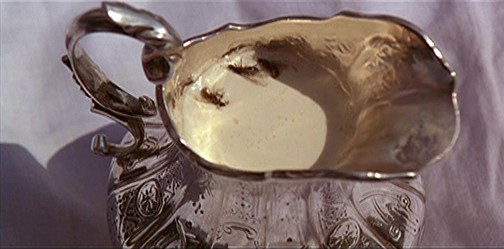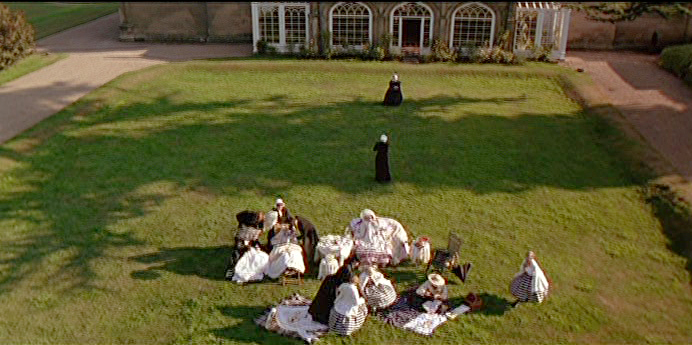Wood ants ruin a picnic in Angels & Insects. It’s a comic episode adapted from A.S. Byatt’s novella, Morpho Eugenia, a novella about predatory deception among the English gentry.
Taking advantage of Midsummer’s Day, the Alabaster family settles for a picnic on the great lawn of Bredely Hall, where they are served strawberries, cream, tea, and cakes. Suddenly, they are engulfed in swarming red ants. *

It’s a multi-edged joke because it’s cliché that ants ruin picnics. And second, the protagonist, William Adamson, is an etymologist. And last, the metaphor of ants in the cream jugs and teacups presages the ruin of Adamson’s marriage to Eugenia Alabaster and the revelation that she has a longstanding incestuous relationship with her brother Edgar.
Intuition prompts William to look for Eugenia is unknown. Racing home, he barges into his bedroom and interrupts Eugenia and Edgar making love. He is mortified. At once undeceived, he knows that Edgar, dressing and hurrying out, and not he is the father of their children. “I know it was bad,” says Eugenia, “but you must understand it didn’t feel bad . . .” Cool and resisting the temptation of anger, William says, “I shan’t touch you,” and throws a sheet so that she can cover herself. You may take this exchange as droll humor or horrendous sensationalism. His words, however, belie that metaphorically he might as well be a dead ant in a cream pot.

The cast: Mark Rylance as William Adamson; Patsy Kensit as Eugenia Alabaster; Kristin Scott Thomas Matty Crompton; Douglas Henshall as Edgar Alabaster
See Philip Haas. Angels & Insects (1995). Screenplay by Philip Haas and Belinda Haas is based on A.S. Byatt’s novella “Morpho Eugenia in Angels & Insects. London: Chatto & Windus, 1992
* Formica sulfamate, wood ants, swarm and mate in the air, after which the males fall dead. Byatt chose Eugenia for Miss Alabaster after Morpho Eugenia, a neotropical butterfly. Adamson mistakes Alabaster’s beauty for the “real” thing forgetting Morpho is blue, but Eugenia’s complexion is an unblemished alabaster sculpture.

